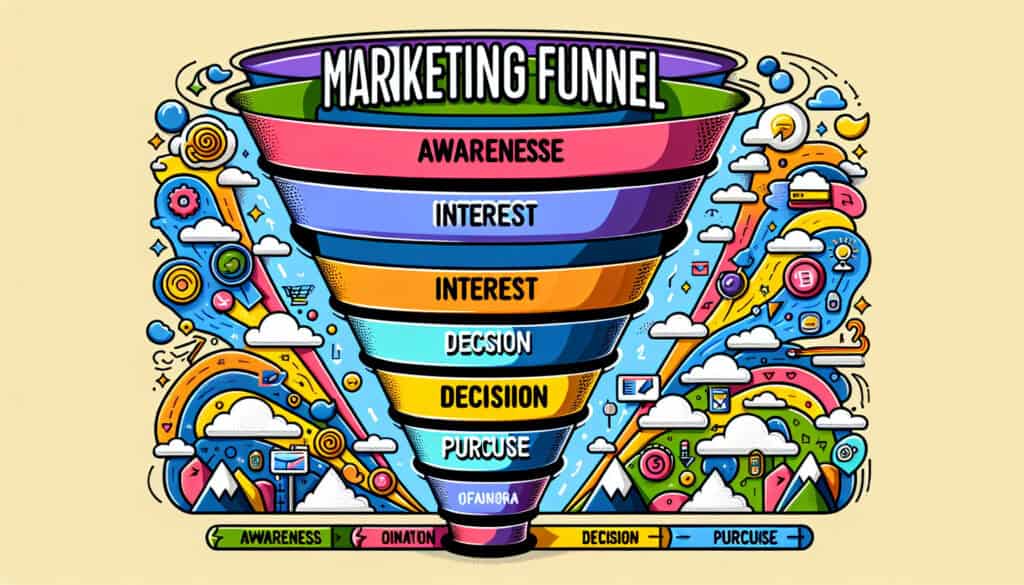Visualiser le parcours du client, de la prise de conscience à l'achat.
- Méthodologies : Clients et marketing, Conception de Produits, Qualité
Entonnoir marketing

Entonnoir marketing
- Taux de conversion, Expérience client, Cartographie de l'itinéraire du client, Commercialisation, Stratégie marketing, Expérience utilisateur (UX), User-Centered Design, Proposition de valeur, Cartographie de la chaîne de valeur
Objectif :
Comment il est utilisé :
- Un modèle qui illustre le parcours théorique du client vers l'achat d'un bien ou d'un service. L'entonnoir est divisé en plusieurs étapes, telles que la sensibilisation, l'intérêt, la considération et la conversion.
Avantages
- Fournit un moyen simple et intuitif de comprendre le parcours du client ; aide à identifier les zones où les clients abandonnent.
Inconvénients
- Peut être trop simpliste et ne pas refléter la nature non linéaire du parcours du client ; se concentre davantage sur l'acquisition que sur la fidélisation.
Catégories :
- Clients et marketing
Idéal pour :
- Comprendre et optimiser le parcours du client pour augmenter les taux de conversion.
Applications of the Commercialisation Funnel can be found across numerous sectors, including technology, retail, healthcare, and education, where understanding consumer behavior is paramount for driving sales and enhancing customer experiences. Typically utilized during the product development and marketing phases, this model encourages teams to examine each stage in depth, offering a clearer view of where strategic adjustments can increase buyer engagement and conversion rates. For instance, in the tech industry, a product team may employ the funnel model to analyze how potential users first learn about a new app, the content that piques their interest, and the factors influencing their decision-making process before committing to download. Participants in this exercise often include marketing strategists, product managers, and UX designers, all working collaboratively to establish effective communication and marketing strategies at each stage. The simplicity of the funnel allows stakeholders to visualize customer interactions effectively, revealing specific drop-off points—such as a website’s checkout page—where potential consumers lose interest, enabling targeted improvements that can significantly boost sales performance. By integrating analytics tools with the funnel methodology, organizations gain quantitative data that can refine campaigns and enhance user outreach across various platforms.
Principales étapes de cette méthodologie
- Définir les segments du public cible en fonction des données démographiques et du comportement.
- Élaborer des stratégies de sensibilisation par le biais de divers canaux de commercialisation.
- Créez un contenu attrayant qui suscite l'intérêt et crée une relation avec les clients potentiels.
- Mettre en œuvre des tactiques qui facilitent l'examen, telles que des comparaisons de produits et des études de cas.
- Optimisez la conversion grâce à des appels à l'action efficaces et à des processus d'achat rationalisés.
- Analyser l'expérience après l'achat afin d'encourager les clients à revenir et à se référer à d'autres personnes.
Conseils de pro
- Tirez parti de l'analyse des données pour surveiller en permanence les taux de conversion à chaque étape et identifier les points de chute en vue d'une intervention ciblée.
- Mettre en œuvre des tests A/B à différentes étapes pour affiner les messages, les visuels et les appels à l'action qui trouvent le plus d'écho auprès des clients.
- Utiliser les boucles de rétroaction des clients après l'achat pour comprendre leur expérience et apporter des améliorations itératives aux étapes de l'entonnoir.
Lire et comparer plusieurs méthodologies, nous recommandons le
> Référentiel méthodologique étendu <
ainsi que plus de 400 autres méthodologies.
Vos commentaires sur cette méthodologie ou des informations supplémentaires sont les bienvenus sur le site web de la Commission européenne. section des commentaires ci-dessous ↓ , ainsi que toute idée ou lien en rapport avec l'ingénierie.
Contexte historique
1910
1957
1960
1980
1980
1986
1990
1994
1950
1957
1970
1980
1983
1990
1992
(si la date est inconnue ou non pertinente, par exemple « mécanique des fluides », une estimation arrondie de son émergence notable est fournie)















Articles Similaires
Questionnaires sur les troubles musculo-squelettiques
Tests à plusieurs variables (MVT)
Analyse de régression multiple
Systèmes de capture de mouvement
Méthode MoSCoW
Test de la médiane de Mood